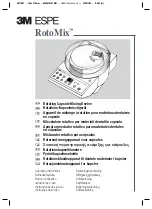
Subject to change without notice
17
The internal trigger threshold of the HM303 is given as
≤
.5div. When the trigger voltage is externally supplied, it
can be measured in V
pp
at the
TRIG. INP.
socket. Normally,
the trigger threshold may be exceeded up to a maximum
factor of 20.
The HM303 has two trigger modes, which are characterized
in the following.
Automatic Triggering
If the
AT/NORM.
pushbutton in the X field is in the out
position
AT
, the sweep generator is running without test
signal or external trigger voltage. A base line is always
displayed even without a signal applied. This trigger mode
is therefore called
Automatic Triggering
. Operation of
the scope needs, having a constantly visible trace, only a
correct amplitude and time base setting. A
LEVEL
adjustment is neither necessary nor possible with auto-
matic triggering. This simple
AT
mode is recommended
for all uncomplicated measuring tasks such as DC voltage
measuring. However, automatic triggering is also the
appropriate operation mode for the "entry" into difficult
measuring problems, e.g. when the test signal is unknown
relating to amplitude, frequency or shape. Presetting of all
parameters is now possible with automatic triggering; the
change to normal triggering can follow thereafter.
The automatic triggering works above
20Hz
.. The change-
over to the break down of the automatic triggering at
frequencies below 20Hz is abrupt. However, it can not be
recognized by the
TRIG.
LED; this is still blinking. Break
down of triggering is best recognizable at the left screen
edge (the start of the trace in differing display height).
If the pulse duty factor of a square-wave signal changes
so much that one part of the square-wave reduces to a
needle pulse, switching over to normal triggering and
using the LEVEL control can be necessary. With automatic
triggering, the trigger point lies approx. in the zero voltage
crossing. The time interval, required for the time base
start, can be too short at a steep zero crossing of the
needle pulse. Then normal triggering should be used.
Automatic triggering is practicable not only with internal
but also with external trigger voltage.
Normal Triggering
With normal triggering (
AT/NORM.
button depressed)
and
LEVEL
adjustment, the sweep can be started by AC
signals within the frequency range selected by the
TRIG.
coupling switch.
In the absence of an adequate trigger
signal or when the trigger controls (particularly the
LEVEL
control) are misadjusted, no trace is visible,
i.e. the screen blanked completely.
When using the internal normal triggering mode, it is
possible to trigger at any amplitude point of a signal edge,
even with very complex signal shapes, by adjusting the
LEVEL
control. Its adjusting range is directly dependent
on the display height, which should be at least
0.5div.
If
it is smaller than 1div., the
LEVEL
adjustment needs to be
operated with a sensitive touch. In the external normal
triggering mode, the same applies to approx. 0.3V external
trigger voltage amplitude.
Other measures for triggering of very complex signals are
the use of the time base variable control and
HOLDOFF
time control, hereinafter mentioned.
Slope
The time base generator can be started by a rising or falling
edge of the test signal. This is valid with automatic and
with normal triggering. The selected slope is set with the
SLOPE (+/–)
pushbutton. The plus sign (button released)
means an edge, which is coming from a negative potential
and rising to a positive potential. That has nothing to do
with zero or ground potential and absolute voltage values.
The positive slope may also lie in a negative part of a
signal. A falling edge (minus sign) triggers, when the
SLOPE
(+/–)
pushbutton is depressed.
However the trigger point may be varied within certain
limits on the chosen edge using the
LEVEL
control. The
slope direction is always related to the input signal and the
non inverted display.
.
Trigger coupling
The coupling mode and accordingly the frequency range
of the trigger signal can be changed using the
TRIG.
selector switch.
AC:
Trigger range
<<<<<
20Hz to 100MHz
.
This is the most frequently used trigger mode. The
trigger threshold is increasing below 20Hz and above
100MHz.
DC:
Trigger range
DC to 100MHz
.
DC triggering is recommended, if the signal is to be
triggered with quite slow processes or if pulse signals
with constantly changing pulse duty factors have to
be displayed.
With DC- or LF-trigger coupling, always work
with normal triggering and LEVEL adjustment.
LF:
Trigger range
DC to 1.5kHz
(low-pass filter).
The LF position is often more suited for low-frequency
signals than the DC position, because the (white) noise
in the trigger voltage is strongly suppressed. So jitter or
double-triggering of complex signals is avoidable or at
least reduced, in particular with very low input voltages.
The trigger threshold increases above 1.5kHz.
TV:
The built-in
active TV-Sync-Separator
enables the
separation of sync pulses from the video signal. Even
distorted video signals are triggered and displayed in
a stable manner.
Video signals are triggered in the automatic mode. The
internal triggering is virtually independent of the display
height, but the sync pulse must exceed 0.5div. height. For
TV sync pulse separation the
TRIG.
switch must be set to
TV
. The
TIME/DIV
.-switch selects between
field
(
.2s/
div. - .2ms/div
.) and
line
(
.1ms/div. - .1µs/div.
).















































